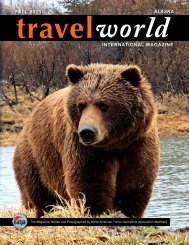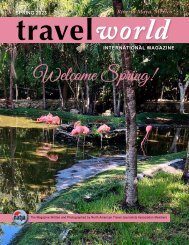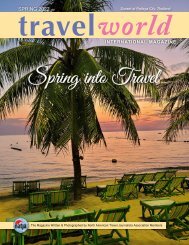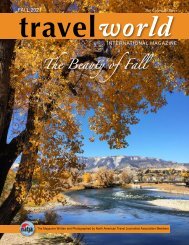TravelWorld International Magazine Fall 2022
The magazine written and photographed by North American Travel Journalists Association members.
The magazine written and photographed by North American Travel Journalists Association members.
You also want an ePaper? Increase the reach of your titles
YUMPU automatically turns print PDFs into web optimized ePapers that Google loves.
Wild and Scenic Portion<br />
rkansas is also the proud home of eight<br />
wild and scenic rivers, including<br />
a portion of the Buffalo River. Its<br />
upper 16 miles are part of the<br />
National Wild and Scenic Rivers<br />
System that’s managed by the<br />
U.S. Forest Service (USFS).<br />
This segment begins at the river’s headwaters<br />
in the Boston Mountains and flows through<br />
the Upper Buffalo Wilderness to the<br />
boundary of the Ozark National Forest.<br />
From the forest boundary, the remaining<br />
135 miles of the river, to its confluence<br />
with the White River, are managed by the<br />
National Park Service. The USFS upper<br />
portion is the river at its wildest and most<br />
primitive. The scenery is spectacular, with<br />
sharp and steep ridges and bluffs, large rock<br />
outcroppings, waterfalls, canyons, and caves.<br />
Hiking, backpacking, and camping are<br />
the most popular uses. The route to iconic<br />
Whitaker Point, also known as Hawksbill<br />
Crag, is the only designated hiking trail, but<br />
a system of old logging roads provides an<br />
informal network of trails for hiking and<br />
horseback riding.<br />
No matter what season or what angle,<br />
Whitaker Point is always photogenic.<br />
The still, clear waters of the Buffalo National<br />
River reflect the surrounding bluffs.<br />
This uppermost section of the river<br />
is definitely not for beginners. Even<br />
experienced whitewater boaters will find it<br />
a challenge. After spring rains, the swollen<br />
upper river is rated Class III-IV in difficulty,<br />
and it has an average drop of 38 feet per<br />
mile.<br />
“A person needs a lot of whitewater<br />
experience,” said Mills, who has probably<br />
floated and hiked the upper section of the<br />
river as many times as anyone. “You have<br />
to be able to run blindly or follow someone<br />
who knows how. You have to be able to<br />
navigate and do a strong roll. If you’re a<br />
whitewater boater, it is great fun. If not, it<br />
can turn into a nightmare.” Because of the<br />
difficulty of this upper segment of the river,<br />
most visitors will opt to float the lower parts<br />
of the Buffalo. Be sure to consult an outfitter<br />
or a park ranger about weather conditions<br />
and the suggested section of the river to suit<br />
your abilities.<br />
The fall colors reflect a mirror image<br />
along the lower portion of the Buffalo<br />
National River in Arkansas.<br />
9
















